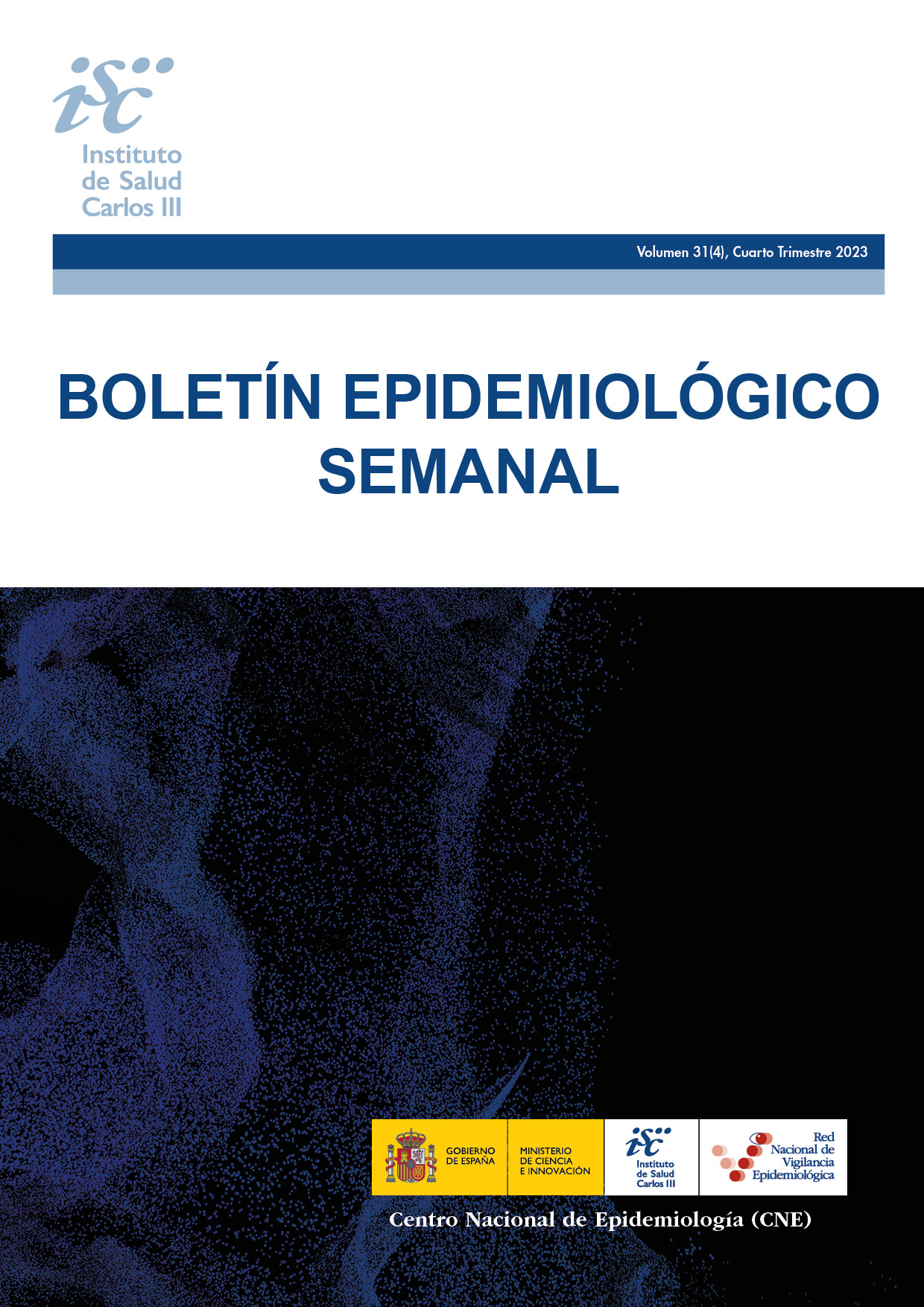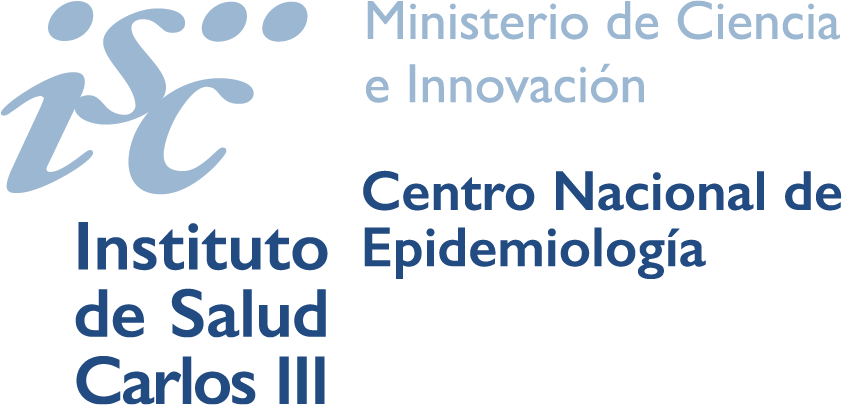Situation of Tularaemia in Spain in 2022. A five-year context overview (2018-2022)
DOI:
https://doi.org/10.4321/s2173-92772023000400003Keywords:
Tularaemia; Francisella tularensis; One Health; Epidemiological surveillanceAbstract
Introduction: Tularaemia is a zoonosis caused by Francisella tularensis. It is a virulent agent that affects humans and a wide range of animal species, surpassing any other known zoonotic microorganism. The objective was to describe the epidemiology of reported tularemia cases in Spain in 2022 in relation to the previous period (2018-2022).
Method: A descriptive analysis of autochthonous tularaemia cases in Spain from 2018 to 2022 was performed by using the notifications to the Spanish National Epidemiological Surveillance Network (RENAVE). The variables analysed were sex, age in ten-year age groups, Autonomous Community (AC) of residence, AC of exposure, and case classification (probable or confirmed).
Results: During the period 2018-2022, 227 cases of tularaemia were reported (incidence rate per 100,000 population IR = 0.09). There was a notable increase in IR in the year 2019 (IR= 0.40) due to an outbreak in Castilla y León. The number of cases was higher in men throughout the entire period, and consequently, the IR. The age group with the highest IR was 50-59 years (IR= 0.18).
Conclusions: In the studied period, specifically in the year 2022, most cases were detected in men aged 40 to 60 years. The significant increase in cases in 2019, with more than 90% of the total cases reported, was due to the outbreak in Castilla y León. It is essential to maintain efforts to control the disease and implement preventive measures to avoid future outbreaks.
Downloads
References
Protocolo de la Red de Vigilancia Epidemiológica de Tularemia. Protocolos de la Red Nacional de Vigilancia Epidemiológica. Instituto de Salud Carlos III. junio de 2015; 646-655.
Maurin M, Gyuranecz M. Tularaemia: clinical aspects in Europe. Lancet Infect Dis. enero de 2016;16(1):113-24. doi: 10.1016/S1473-3099(15)00355-2
European Food Safety Authority, European Centre for Disease Prevention and Control. The European Union One Health 2021 Zoonoses Report. EFSA Journal. 2022;20(12):e07666. doi: 10.2903/j.efsa.2022.7666
Allue M, Sopeña CR, Gallardo MT, Mateos L, Vian E, Garcia MJ, et al. Tularaemia outbreak in Castilla y León, Spain, 2007: an update. Eurosurveillance. 7 de agosto de 2008;13(32):18948. PMID: 18761900
Anda P, Segura del Pozo J, Díaz García JM, Escudero R, García Peña FJ, López Velasco MC, et al. Waterborne outbreak of tularemia associated with crayfish fishing. Emerg Infect Dis. 2001;7(3 Suppl):575-82. doi: 10.3201/eid0707.010740
Hestvik G, Warns-Petit E, Smith LA, Fox NJ, Uhlhorn H, Artois M, et al. The status of tularemia in Europe in a one-health context: a review. Epidemiology & Infection. julio de 2015;143(10):2137-60. doi: 10.1017/S0950268814002398
Keim P, Johansson A, Wagner DM. Molecular epidemiology, evolution, and ecology of Francisella. Ann N Y Acad Sci. junio de 2007;1105:30-66. doi: 10.1196/annals.1409.011
Petersen JM, Mead PS, Schriefer ME. Francisella tularensis: an arthropod-borne pathogen. Vet Res. 2009;40(2):07. doi: 10.1051/vetres:2008045
Informe epidemiológico sobre la situación de la Tularemia en España. Años 2019, 2020, 2021. Centro Nacional de Epidemiología. Instituto de Salud Carlos III. febrero de 2022.
Lebas F, Coudert P, Rochambeau H, Thébault RG. El conejo: cría y patología. Nueva versión revisada. Roma: Organización de las Naciones Unidas para la Agricultura y la Alimentación; 1996. 227 p. (FAO animal production and health series).
Yeni DK, Büyük F, Ashraf A, Shah MSUD. Tularemia: a re-emerging tick-borne infectious disease. Folia Microbiol (Praha). febrero de 2021;66(1):1-14. doi: 10.1007/s12223-020-00827-z
Kudryavtseva TY, Mokrievich AN. Tularemia in the world. Russian Journal of Infection and Immunity. 2021;11(2):249-64. doi: 10.15789/2220-7619-TTW-1380
Heymann DL, Control of communicable diseases manual. An official report of the American Public Health Association. 20º Ed. Apha Press. 2015; pp.650-654.
Rodríguez-Ferri EF. Tularemia. Una aproximación a su estudio integral en Castilla y León. León: Consejería de Agricultura y Ganadería. Junta de Castilla y León. 2017.
Real Decreto 2210/1995, de 28 de diciembre, por el que se crea la red nacional de vigilancia epidemiológica. Sec. 1, BOE nº 21, de 24 de enero de 1996 p. 2153-8.
Decisión de la Comisión (UE) 2018/945 de 22 de junio de 2018, on the communicable diseases and related special health issues to be covered by epidemiological surveillance as well as relevant case definitions. Vol 61. 6 July 2018.
Nuevo brote de tularemia en Castilla y León. Real Academia de Ciencias Veterinarias. RACVE. Disponible en: https://www.racve.es/publicaciones/nuevo-brote-de-tularemia-en-castilla-y-leon/
Protocolo de vigilancia de Tularemia de la Red de Vigilancia Epidemiológica de la Comunidad de Madrid. Dirección General de Salud Pública. junio de 2023.
Carvalho CL, Lopes de Carvalho I, Zé-Zé L, Núncio MS, Duarte EL. Tularaemia: a challenging zoonosis. Comp Immunol Microbiol Infect Dis. marzo de 2014;37(2):85-96. doi: 10.1016/j.cimid.2014.01.002
Faber M, Heuner K, Jacob D, Grunow R. Tularemia in Germany: a re-emerging zoonosis. Front Cell Infect Microbiol. 16 de febrero de 2018;8:40. doi: 10.3389/fcimb.2018.00040.
Downloads
Published
How to Cite
Issue
Section
License
Copyright (c) 2023 Daniel Cifo, Raquel Barba-Sánchez, Diana Gomez-Barroso, Rosa Mª Estévez-Reboredo

This work is licensed under a Creative Commons Attribution-NonCommercial-ShareAlike 4.0 International License.
El material creado por un autor puede ser distribuido, copiado y exhibido por terceros si se hace referencia a la autoría. No se puede obtener ningún beneficio comercial y las obras derivadas tienen que estar bajo los mismos términos de licencia que el trabajo original


